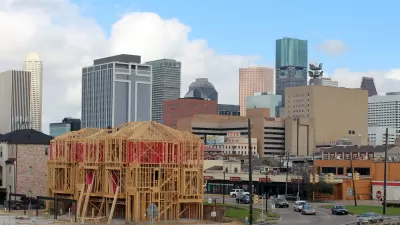Affordable housing is one piece of a larger, interconnected approach.

In an excerpt from Fragile Neighborhoods: Repairing American Society, One Zip Code at a Time published in Next City, Seth D. Kaplan calls for a more holistic approach to solving the related problems of poverty, housing insecurity, and a lack of economic opportunity.
Whether in an urban or suburban neighborhood, a suitable habitat should include a commercial center — an avenue, cluster of shops, or plaza — as well as parks, libraries, and houses of worship, which provide everyday facilities and services as well as places for people to gather and interact. And it should include transit points, connecting residents to people and opportunities outside the neighborhood, as well as contiguous sidewalks affording residents walkable access to other areas within the neighborhood.
Quoting sociologist Emily Talen, Kaplan notes that many “neighborhoods in the US are overwhelmingly not well serviced.” Residents with means move to other areas, leaving poor neighborhoods even more underresourced. For Kaplan, “Without healthy neighborhoods, school systems cannot improve educational results, health care agencies cannot improve health outcomes, and police cannot make streets safe. Yet the great majority of public and private interventions are not structured to address the underlying social dynamics that produced these problems in the first place.”
FULL STORY: Affordable Housing Is Never the Only Problem – Or the Only Solution

Maui's Vacation Rental Debate Turns Ugly
Verbal attacks, misinformation campaigns and fistfights plague a high-stakes debate to convert thousands of vacation rentals into long-term housing.

Planetizen Federal Action Tracker
A weekly monitor of how Trump’s orders and actions are impacting planners and planning in America.

In Urban Planning, AI Prompting Could be the New Design Thinking
Creativity has long been key to great urban design. What if we see AI as our new creative partner?

King County Supportive Housing Program Offers Hope for Unhoused Residents
The county is taking a ‘Housing First’ approach that prioritizes getting people into housing, then offering wraparound supportive services.

Researchers Use AI to Get Clearer Picture of US Housing
Analysts are using artificial intelligence to supercharge their research by allowing them to comb through data faster. Though these AI tools can be error prone, they save time and housing researchers are optimistic about the future.

Making Shared Micromobility More Inclusive
Cities and shared mobility system operators can do more to include people with disabilities in planning and operations, per a new report.
Urban Design for Planners 1: Software Tools
This six-course series explores essential urban design concepts using open source software and equips planners with the tools they need to participate fully in the urban design process.
Planning for Universal Design
Learn the tools for implementing Universal Design in planning regulations.
planning NEXT
Appalachian Highlands Housing Partners
Mpact (founded as Rail~Volution)
City of Camden Redevelopment Agency
City of Astoria
City of Portland
City of Laramie





























